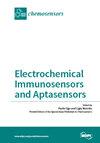研究用于检测二氧化硫的还原氧化石墨烯传感器上的金属纳米颗粒装饰
IF 3.7
3区 工程技术
Q2 CHEMISTRY, ANALYTICAL
引用次数: 0
摘要
本文介绍了用金属纳米粒子装饰还原氧化石墨烯(rGO)对检测二氧化硫(SO2)的影响。我们采用铜和铂来生产金属纳米粒子(NPs),对还原氧化石墨烯进行化学和物理装饰,形成纳米复合材料(rGO/NPs)。我们分别通过改变化学和物理装饰的金属离子浓度和沉积时间来优化 NP 负载。化学装饰在 rGO 表面呈现出随机的纳米颗粒分布,颗粒大小分布广泛(1 到 100 nm,大部分小于 40 nm)。相比之下,物理装饰呈现出均匀分布的纳米颗粒,颗粒大小在 1 到 20 纳米之间,大部分小于 10 纳米。化学装饰结构呈现出最佳的气体响应,并显示出较低的 NP 负载可提供更好的响应。纳米复合材料之所以能产生反应,是因为 NPs 与 rGO 表面之间产生了更好的协同作用,再加上 NPs 对 rGO 的催化作用。物理装饰使 NP 表面覆盖率高于化学装饰,但这意味着气态分子相互作用的剩余 rGO 裸露表面较少。这些结果表明,NPs 表面和未覆盖的 rGO 对气体反应有促进作用。本文章由计算机程序翻译,如有差异,请以英文原文为准。
Investigating the Metallic Nanoparticles Decoration on Reduced Graphene Oxide-Based Sensors Used to Detect Sulfur Dioxide
This paper presents the impact of the decoration of reduced graphene oxide (rGO) with metallic nanoparticles to detect sulfur dioxide (SO2). Copper and platinum were employed to produce metal nanoparticles (NPs) for the chemical and physical decoration of rGO to form the nanocomposites (rGO/NPs). We optimized NP loading by varying the concentrations of metal ions and deposition times for chemical and physical decoration, respectively. The chemical decoration presents a random nanoparticle distribution on the rGO surface with a broad particle size distribution (1 to 100 nm with a majority less than 40 nm). In comparison, the physical decoration presents uniformly distributed nanoparticles with particles of a size between 1 and 20 nm, with a majority less than 10 nm. The chemically decorated structures present the best gas responses and show that lower NP loading provides better responses. The nanocomposites present responses owing to a better synergy between NPs and the rGO surface, combined with the catalytic action of the NPs on the rGO. The physical decoration allows higher NP surface coverage than the chemical one but implies a lower remaining rGO naked surface for gaseous molecule interaction. These results illustrate that the NPs’ surface and the uncovered rGO contribute to the gas response.
求助全文
通过发布文献求助,成功后即可免费获取论文全文。
去求助
来源期刊

Chemosensors
Chemistry-Analytical Chemistry
CiteScore
5.00
自引率
9.50%
发文量
450
审稿时长
11 weeks
期刊介绍:
Chemosensors (ISSN 2227-9040; CODEN: CHEMO9) is an international, scientific, open access journal on the science and technology of chemical sensors published quarterly online by MDPI.
 求助内容:
求助内容: 应助结果提醒方式:
应助结果提醒方式:


